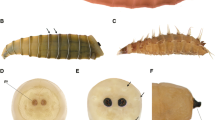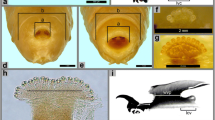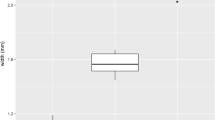Abstract
Several necrophagous Coleoptera species are frequently collected on cadavers, may occasionally act as intermediate or paratenic hosts of parasites, as vectors of pathogens or as allergens, and can also represent major pests of preserved animal products. However, despite their medical, veterinary and economic importance, there is a lack of reliable species identification tools for the larval stages (usually the only entomological evidence associated with medicolegal investigations), thus severely limiting their potential application as forensic indicators. Here, we provide an identification key to the larvae of the necrophagous Coleoptera species which have been recorded on carrion in the western Palaearctic region, based on easily observable morphological characters. In total, we provide diagnostic characters for the reliable identification of 23 necrophagous Coleoptera species within four different families (Cleridae, Dermestidae, Nitidulidae and Silphidae). In addition to the aforementioned families, we provide diagnostic characters for the identification of the larvae of families Histeridae, Staphylinidae and Trogidae, which can also be collected on cadavers. It is expected that the present key will facilitate the identification of larval material of necrophagous Coleoptera collected either in carrion succession studies or during medicolegal investigations, in order to further advance in the potential use of this insects as forensic tools.





Similar content being viewed by others
References
Amendt J, Richards CS, Campobasso CP, Zehner R, Hall MJR (2011) Forensic entomology: applications and limitations. Forensic Sci Med Pathol 7:379–392
Braack LEO (1987) Community dynamics of carrion-attendant arthropods in tropical African woodland. Oecologia 72:402–409
Bajerlein D, Taberski D, Matuszewski S (2018) Estimation of postmortem interval (PMI) based on empty puparia of Phormia regina (Meigen) (Diptera: Calliphoridae) and third larval stage of Necrodes littoralis (L.) (Coleoptera: Silphidae) – advantages of using different PMI indicators. J Forensic Legal Med 55:95–98
Midgley JM, Villet MH (2009) Development of Thanatophilus micans (Fabricius, 1794) (Coleoptera: Silphidae) at constant temperatures. Int J Legal Med 123:285–292
Matuszewski S, Szafałowicz M, Jarmusz M (2013) Insect colonizing carcasses in open and forest habitats of Central Europe: search for indicators of corpse relocation. Forensic Sci Int 231:234–239
Charabidze D, Colard T, Vincent B, Pasquerault T, Hedoiun V (2014) Involvement of larder beetles (Coleoptera: Dermestidae) on human cadavers: a review of 81 forensic cases. Int J Legal Med 128:1021–1030
Midgley JM, Richards CS, Villet MH (2010) The utility of Coleoptera in forensic investigations. In: Amendt J, Goff ML, Campobasso CP, Grassberger M (eds) Current concepts in forensic entomology. Springer, Dordrecht, pp 57–68
Martín-Vega D, Díaz-Aranda LM, Baz A, Cifrián B (2017) Effect of temperature on the survival and development of three forensically relevant Dermestes species (Coleoptera: Dermestidae). J Med Entomol 54:1140–1150
Schroeder H, Klotzbach H, Oesterhelweg L, Püschel K (2002) Larder beetles (Coleoptera, Dermestidae) as an accelerating factor for decomposition of a human corpse. Forensic Sci Int 127:231–236
Matuszewski S, Bajerlein D, Konwerski S, Szpila K (2010) Insect succession and carrion decomposition in selected forests of Central Europe. Part I: pattern and rate of decomposition. Forensic Sci Int 194:85–93
Hinton HE (1945) A monograph of the beetles associated with stored products, volume I. Trustees of the British museum (natural history), London
Solter LF, Lustigman B, Shubeck P (1989) Survey of medically important true bacteria found associated with carrion beetles (Coleoptera: Silphidae). J Med Entomol 26:354–359
Fischer OA, Matlova L, Dvorska L, Svastova P, Peral DL, Weston RT, Bartos M, Pavlik I (2004) Beetles as possible vectors of infections caused by Mycobacterium avium species. Vet Microbiol 102:247–255
Hagstrum D (2013) Atlas of stored-product insects and mites. Academic Press, Minnesota
Riva E, Fiel C, Steffan P (2015) The immature stages of Dermestes maculatus, Sarcophaga sp. and Phaenicia sericata as potential paratenic hosts for Trichinella spiralis in nature. Parasitol Res 114:149–154
Boheme P, Amendt J, Zehner R (2011) The use of COI barcodes for molecular identification of forensically important fly species in Germany. Parasitol Res 110:2325–2332
Grzywacz A, Hall MJR, Pape T, Szpila K (2017) Muscidae (Diptera) of forensic importance—an identification key to third instar larvae of the western Palaearctic region and a catalogue of the muscid carrion community. Int J Legal Med 131:855–866
Daniel CA, Midgley JM, Villet MH (2017) Determination of species and instars of the larvae of the Afrotropical species of Thanatophilus leach, 1817 (Coleoptera, Silphidae). Afr Invertbr 58:1–10
Ortloff A, Zanetti N, Centeno N, Silva R, Bustamante F, Olave A (2014) Ultramorphological characteristics of mature larvae of Nitidula carnaria (Schaller 1783) (Coleoptera: Nitidulidae), a beetle species of forensic importance. Forensic Sci Int 239:e1–e9
Arnaldos MI, Romera E, Presa JJ, Luna A, García MD (2004) Studies on seasonal arthropod succession on carrion in southeastern Iberian Peninsula. Int J Legal Med 118:197–205
Anton E, Niederegger S, Beutel RG (2011) Beetles and flies collected on pig carrion in an experimental setting in Thuringia and their forensic implications. Med Vet Entomol 25:353–364
Prado e Castro C, García MD, Martins da Silva P, Faria e Silva I, Serrano A (2013) Coleoptera of forensic interest: a study of seasonal community composition and succession in Lisbon, Portugal. Forensic Sci Int 232:73–83
Mądra A, Frątczak K, Grzywacz A, Matuszewski S (2015) Long-term study of pig carrion entomofauna. Forensic Sci Int 252:1–10
Zhantiev RD, Volkova TG (1998) Larvae of dermestid beetles of the genus Dermestes (Coleoptera, Dermestidae) of Russia and adjacent countries: 1. Subgenus Dermestes. Entomol Rev 78:962–968
Zhantiev RD, Volkova TG (1999) Larvae of dermestid beetles of the genus Dermestes (Coleoptera, Dermestidae) of Russia and adjacent countries: 2. Subgenus Dermestinus. Entomol Rev 79:107–117
Byrd JH, Castner JL (2001) Insects of forensic importance. In: Byrd JH, Castner JL (eds) Forensic entomology: the utility of arthropods in legal investigations. CRC Press LLC, Boca Raton, Florida, pp 43–78
Kulshrestha P, Satpathy DK (2001) Use of beetles in forensic entomology. Forensic Sci Int 120:15–17
Charabidze D, Vincent B, Pasquerault T, Hedouin V (2016) The biology and ecology of Necrodes littoralis, a species of forensic interest in Europe. Int J Legal Med 130:273–280
Novák M, Jakubec P, Qubaiová J, Šuláková H, Růžička J (2018) Revisited larval morphology of Thanatophilus rugosus (Coleoptera: Silphidae). Int J Legal Med 132:939–954
Díaz Martín B, Saloña Bordas MI (2012) Primera cita y nuevos datos sobre los hábitos necrófagos de Trox scaber (Linnaeus, 1767) (Coleoptera, Trogidae) en la Comunidad Autónoma del País Vasco (C.A.P.V.). Bol Asoc Esp Ent 36:53–59
Matuszewski S, Szafałowicz M (2013) Temperature-dependent appearance of forensically useful beetles on carcasses. Forensic Sci Int 229:92–99
Díaz-Aranda LM, Martín-Vega D, Gómez-Gómez A, Cifrián B, Baz A (2018) Annual variation in decomposition and insect succession at a periurban area of Central Iberian Peninsula. J Forensic Legal Med 56:21–31
Benecke M (1998) Six forensic entomology cases: description and commentary. J Forensic Sci 43:797–805
Grassberger M, Frank C (2004) Initial study of arthropod succession on pig carrion in a central European urban habitat. J Med Entomol 41:511–523
Saloña MI, Moraza ML, Carles-Tolrá M, Iraola V, Bahillo P, Yélamos T, Outerelo R, Alcaraz R (2010) Searching the soil: forensic importance of edaphic fauna after the removal of a corpse. J Forensic Sci 55:1652–1655
Bonacci T, Greco S, Zetto Brandmayr T (2011) Insect fauna and degradation activity of Thanatophilus species on carrion in southern Italy (Coleoptera: Silphidae). Entomol Gener 33:63–70
Matuszewski S, Frątczak K, Konwerski S, Bajerlein D, Szpila K, Jarmusz M, Szafałowicz M, Grzywacz A, Mądra A (2016) Effect of body mass and clothing on carrion entomofauna. Int J Legal Med 130:221–232
Arnaldos MI, García MD, Romera E, Presa JJ, Luna A (2005) Estimation of postmortem interval in real cases based on experimentally obtained entomological evidence. Forensic Sci Int 149:57–65
García-Rojo AM, Honorato L, González M, Téllez A (2009) Determinación del intervalo postmortem mediante el estudio de la sucesión de insectos en dos cadáveres hallados en el interior de una finca rústica en Madrid. Cuad Med Forense 15:137–145
Alajmi RA, AlGhufaili H, Farrukh A, Aljohani H, Mashaly AMA (2016) First report of necrophagous insects on human corpses in Riyadh, Saudi Arabia. J Med Entomol 53:1276–1282
Bonacci T, Vercillo V, Benecke M (2017) Dermestes frischii and D. undulatus (Coleoptera: Dermestidae) on a human corpse in southern Italy: first report. Rom J Legal Med 25:180–184
Rees BE (1947) Taxonomy of the genus Dermestes (Coleoptera: Dermestidae). Proc Ent Soc Wash 49:1–14
Abouzied EM (2014) Insect colonization and succession on rabbit carcasses in southwestern mountains of the Kingdom of Saudi Arabia. J Med Entomol 51:1168–1174
Zanetti NI, Visciarelli EC, Centeno ND (2013) Preliminary data on larval morphology and life cycle of Nitidula carnaria (Coleoptera: Nitidulidae), a species of forensic interest. Rev Soc Entomol Arg 72:195–198
Böving AG, Rozen JG Jr (1962) Anatomical and systematic study of the mature larvae of the Nitidulidae (Coleoptera). Entomol Medd 31:265–299
Hayashi N (1978) A contribution to the knowledge of the larvae of Nitidulidae occurring in Japan (Coleoptera: Cucujoidea). Insecta Matsumurana 14:1–97
von Lengerken H (1929) Studien über die Lebenserscheinungen der Silphini (Col.). XI-XIII. Thanatophilus sinuatus F., rugosus L. und dispar Hrbst. Z Morphol Ökol Tiere 14:654–666
Castillo-Miralbés M (2001) Principales especies de coleópteros necrófagos presentes en carroña de cerdos en la comarca de La Litera (Huesca). Graellsia 57:85–90
Martín-Vega D, Baz A (2012) Spatiotemporal distribution of necrophagous beetles (Coleoptera: Dermestidae, Silphidae) assemblages in natural habitats of Central Spain. Ann Entomol Soc Am 105:44–53
Martín-Vega D, Baz A (2011) Could the ‘vulture restaurants’ be a lifeboat for the recently rediscovered bone-skippers (Diptera: Piophilidae)? J Insect Conserv 15:747–753
Baz A, Botías C, Martín-Vega D, Cifrián B, Díaz-Aranda LM (2015) Preliminary data on carrion insects in urban (indoor and outdoor) and periurban environments in Central Spain. Forensic Sci Int 248:41–47
Midgley JM, Villet MH (2009) Effect of the killing method on post-mortem change in length of larvae of Thanatophilus micans (Fabricius 1794) (Coleoptera: Silphidae) stored in 70% ethanol. Int J Legal Med 123:103–108
Růžička J (1992) The immature stages of central European species of Nicrophorus (Coleoptera, Silphidae). Acta Entomol Bohemoslov 89:113–135
Scholtz CH, Lumaret JP (1991) Descriptions of European Trox F. Larvae (Coleoptera: Trogidae). Coleopt Bull 45:317–322
Smith KGV (1986) A manual of forensic entomology. British Museum (Natural History) and Cornell University Press, London
Scott H (1919) Notes on the biology of Necrobia ruficollis, Fabr. (Coleoptera, Cleridae). Ann Appl Biol 6:101–115
Růžička J, Vit S (2017) Fauna Europaea: Silphidae In: Alonso-Zarazaga MA (ed) Fauna Europaea: Coleoptera Fauna Europaea version 2017.06, https://fauna-eu.org [accessed: 15/05/2018]
Frątczak K, Matuszewski S (2014) Instar determination in forensically useful beetles Necrodes littoralis (Silphidae) and Creophilus maxillosus (Staphylinidae). Forensic Sci Int 241:20–26
Frątczak K, Matuszewski S (2016) Classification of forensically relevant larvae according to instar in a closely related species of carrion beetles (Coleoptera: Silphidae: Silphinae). Forensic Sci Med Pathol 12:193–197
Charabidze D, Gosselin M, Hedouin V (2017) Use of necrophagous insects as evidence of cadaver relocation: myth or reality? PeerJ 5:e3506
Audisio P, Kovar I, Pasqual C, van Vondel BJ (2018) Fauna Europaea: Dermestidae In: Alonso-Zarazaga MA (ed) Fauna Europaea: Coleoptera Fauna Europaea version 2017.06, https://fauna-eu.org [accessed: 15/05/2018]
Mądra A, Konwerski S, Matuszewski S (2014) Necrophilous Staphylininae (Coleoptera: Staphylinidae) as indicators of season of death and corpse relocation. Forensic Sci Int 242:32–37
Martín-Vega D, Cifrián B, Díaz-Aranda LM, Baz A (2015) Necrophilous histerid beetle communities (Coleoptera: Histeridae) in Central Spain: species composition and habitat preferences. Environ Entomol 44:966–974
Acknowledgements
We are grateful to Szymon Matuszewski (Adam Mickiewicz University, Poznań, Poland) for kindly providing larval specimens of Oiceoptoma thoracicum and Creophilus maxillosus. We are also grateful to the president of the European Association for Forensic Entomology, Luc Bourguignon, for providing statistics on the EAFE collaborative identification exercise. Two anonymous reviewers provided useful comments and suggestions on the present manuscript. Authors’ research is supported by the IUICP (Instituto Universitario de Investigación en Ciencias Policiales). D.M.-V was supported by a fellowship from the University of Alcalá (Ayudas Postdoctorales UAH).
Author information
Authors and Affiliations
Corresponding author
Ethics declarations
Conflict of interest
The authors declare that they have no conflict of interest.
Rights and permissions
About this article
Cite this article
Díaz-Aranda, L.M., Martín-Vega, D., Baz, A. et al. Larval identification key to necrophagous Coleoptera of medico-legal importance in the western Palaearctic. Int J Legal Med 132, 1795–1804 (2018). https://doi.org/10.1007/s00414-018-1909-2
Received:
Accepted:
Published:
Issue Date:
DOI: https://doi.org/10.1007/s00414-018-1909-2




